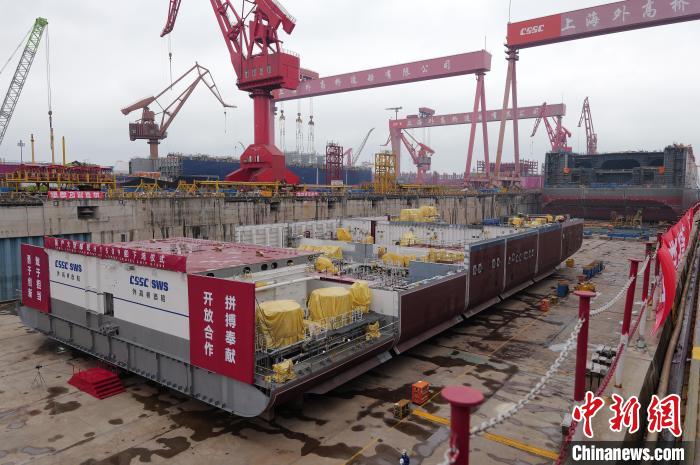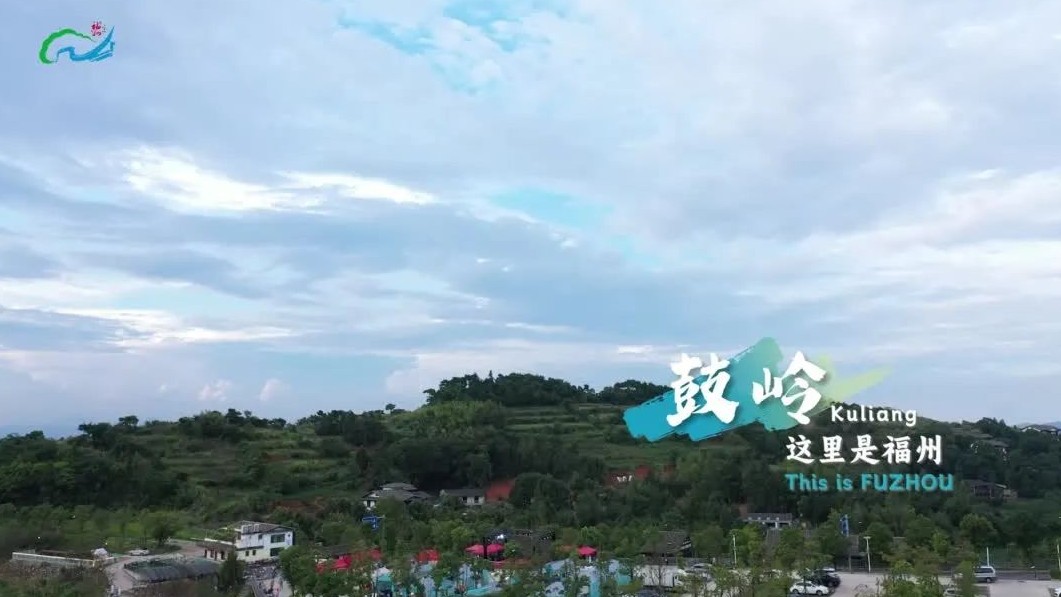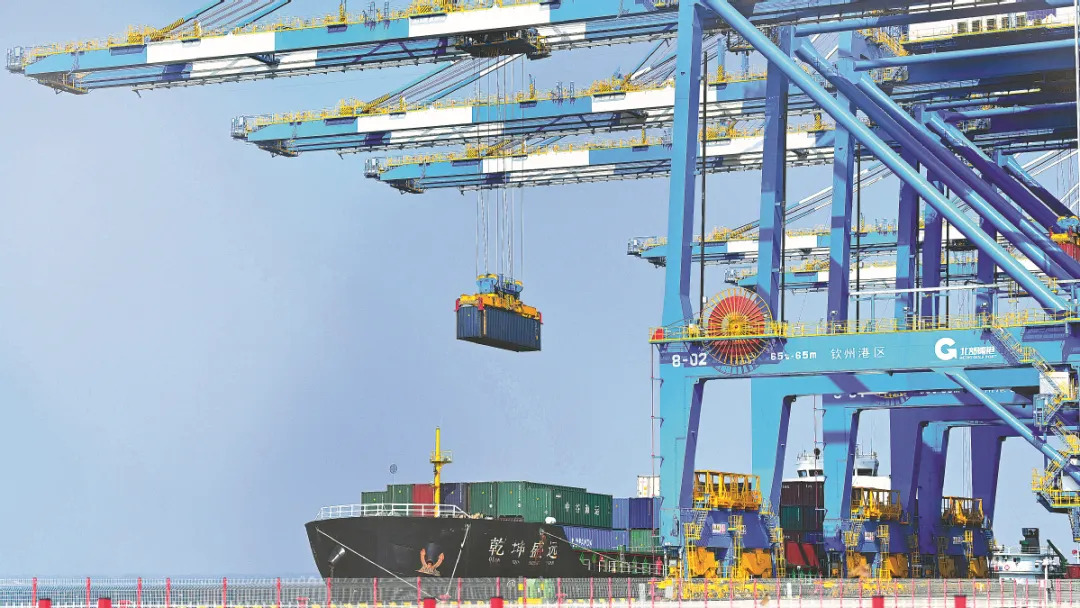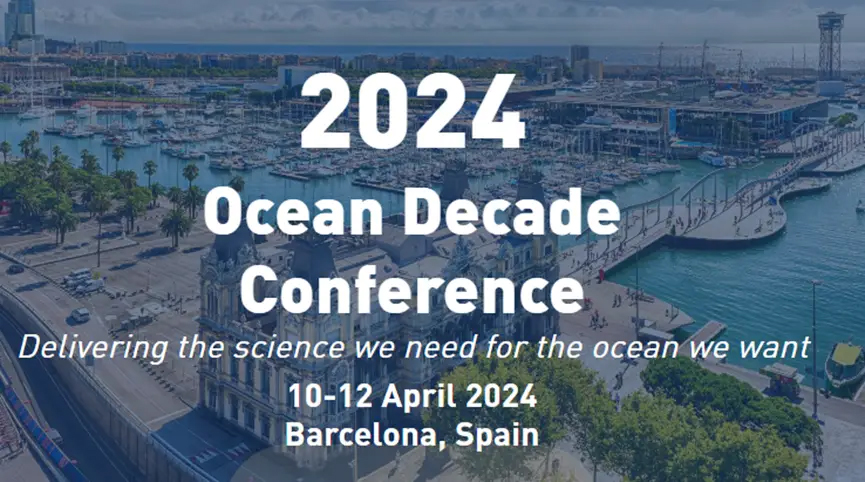





A keel laying ceremony of China's second domestically-produced large cruise ship was held on Saturday morning in Shanghai, marking the onset of the vessel's hull structure assembly and another achievement of China's shipbuilding prowess, according to official sources.
Chen Gang, general manager of the vessel's builder China State Shipbuilding Corporation's (CSSC) Shanghai Waigaoqiao Shipbuilding Co Ltd called the ceremony a milestone in China's cruise industry development.
"In comparison with the first one, the second homegrown cruise ship was built more efficiently in terms of design and construction, with higher quality and standards," said Chen.
The vessel has currently completed 20 percent of its total construction workload, with its design, construction, procurement and logistics well underway.
Garnering ample experience from building the first China-made cruise ship Adora Magic City, CSSC has optimized the construction of a second large cruise ship and enhanced the efficiency by 20 percent, said Chen Jianwei, assistant to the general manager of China State Shipbuilding Corporation's (CSSC) Shanghai Waigaoqiao Shipbuilding Co Ltd.
The efficiency improvement will come along with design optimization, including supply chain development and management, as well as process innovation, according to Chen.
To be named and delivered by the end of 2026, the vessel is expected to get floated in May 2025, which means its construction is at the halfway mark and ready for undocking in March 2026, said Chen, who is also the construction director of Shanghai Waigaoqiao Shipbuilding's large cruise project.
The 141,900-gross-tonnage ship will be 341-meter-long and 37.2-meter-wide, 17.4 meters longer than the first one. In the meantime, the vessel will add 19 more guest rooms to expand its rooms to 2,144.
China's first self-made cruise ship Adora Magic City launched its maiden commercial voyage on the first day of 2024, and has successfully completed 26 trips and served more than 100,000 passengers home and abroad so far, official sources said.
Source: Chinanews.com
2024-04-22
details


Manny Webber is an art student studying in New York City and has been passionate about Chinese culture since childhood. Manny said that Chinese food, music, and the Chinese community's family values have all influenced him. As an art student, he feels empowered by the way Chinese culture tells stories with color and emotion. He also said that Chinese culture focuses on harmony rather than conflict, trying to find balance in things.
Source: CGTN
2024-04-19
details


Source: Chinese Headline New Media
2024-04-17
details


The Belt and Road Initiative has catalyzed socioeconomic development in Malaysia and the broader region. As the BRI embarks on its second decade, expectations are high that it will continue to facilitate the transition of the developing world toward more sustainable growth and enable it to embrace the opportunities presented by the Fourth Industrial Revolution.
In 1974, Chairman Mao Zedong and then Malaysian prime minister Tun Abdul Razak convened in Beijing to establish diplomatic relations between China and Malaysia. This year commemorates the 50th anniversary of that historic event. Half a century later, the bond between the two countries has never been stronger.
In 2023, Malaysian Prime Minister Anwar Ibrahim made two visits to China, emphasizing the significant importance he places on fostering a strong relationship between the two countries. Among various agreements, Prime Minister Anwar and Chinese President Xi Jinping committed to cultivating trust between the world's diverse cultures through the Global Civilization Initiative.
Economic cooperation has always been the cornerstone of the China-Malaysia relationship. Over the past decade, the BRI has emerged as a pivotal catalyst, further driving and shaping this robust economic collaboration between the two nations. In 2022, China-Malaysia trade reached $203.59 billion, up 15.3 percent year-on-year. China has been the largest trading partner of Malaysia for 15 consecutive years since 2009, accounting for 17.1 percent of Malaysia's total external trade in 2023.
The BRI carries unique historic significance for the China-Malaysia relationship. The maritime route retraces the 15th century voyages of Admiral Zheng He, who made notable stopovers in the Sultanate of Melaka. These visits during the Ming Dynasty (1368-1644) laid the foundation for the initial diplomatic and civilization ties between ancient China and the Malay world. Naturally, the BRI today serves as a rekindling of an old friendship established some 600 years ago.
Over the past decade, China has invested in a diverse array of projects in Malaysia through the BRI, including the East Coast Railway Link, the Malaysia-China Kuantan Industrial Park, the Trans-Sabah Gas Pipeline and various others.
These initiatives have generated significant development and transformed Malaysia's social and economic landscape. However, the COVID-19 pandemic caused disruptions to the progress of the BRI in Malaysia, as it did elsewhere.
Great power rivalry and geopolitical tension have also posed challenges, with trade tariffs and sanctions disrupting supply chains and undermining economic growth. Malaysia, along with the Association of Southeast Asian Nations in general, remains committed to a policy of open and free trade, actively engaging with China and all other relevant stakeholders dedicated to fostering the common good.
In fact, since its inception, the BRI has evolved beyond the conventional infrastructure focus, expanding into diverse sub-initiatives such as the Health Silk Road, the Green Silk Road, and the Digital Silk Road.
The Health Silk Road, for instance, has become part of the BRI framework in Malaysia. During the COVID-19 pandemic, China's assistance in supplying vaccines not only aided Malaysia in managing the crisis, but also facilitated the development of China's own vaccine capabilities. Subsequently, China has committed to supporting Malaysia's vaccine research and production, reflecting a collaborative effort aligned with the Health Silk Road's goal of enhancing global public health.
In recent years, China has emerged as a trailblazer in renewable energy and green manufacturing. Through the framework of the Green Silk Road, it strategically positions itself at the vanguard of the global green technological revolution, benefiting developing countries such as Malaysia. Beyond solar panels and electric vehicles, Chinese-manufactured hydrogen buses are playing a pivotal role in Malaysia's ongoing transition to renewable energy.
China's remarkable transformation into a technological powerhouse has given rise to another new subdivision, namely, the Digital Silk Road. This initiative is expected to assist Malaysia and other nations in embracing the digital age. For example, Huawei is anticipated to launch Malaysia's second 5G network, contributing significantly to the country's technological progress. Moreover, Alibaba has selected Malaysia as its regional e-commerce hub and has entered into an agreement to transform Kuala Lumpur into the first "smart city" outside of China using Alibaba technology.
In 2023, while visiting the China-ASEAN Expo in Nanning, the Guangxi Zhuang autonomous region, Prime Minister Anwar secured China's renewed commitment to support Putrajaya's New Industrial Master Plan 2030. This plan is expected to harness the Digital Silk Road to propel Malaysia into a high-tech nation.
As the China-Malaysia relationship celebrates its 50th anniversary, the two countries are expected to enter into a new era of closer people-to-people bonds and enhanced economic cooperation, driven by a revitalized BRI.
Indeed, as it embarks on its second decade, the BRI has evolved into "a road of science and technology" that places innovation high on the agenda, ready to expedite the transition of the developing world, including Malaysia, into the digital age and a future defined by technological possibilities.
Source: Chinadaily.com.cn
2024-04-16
details


On April 10, local time, the 2024 United Nations Decade of Ocean Science for Sustainable Development (2021-2030) (hereinafter referred to as the Ocean Decade) Conference was held in Barcelona, Spain. Sun Shuxian, Vice Minister of the Ministry of Natural Resources of China and Director of the State Oceanic Administration, led a delegation to attend the meeting and delivered a speech at the opening ceremony. The Ministry of Natural Resources held a number of side events around themes such as maritime culture, the Digital Deep-sea Typical Habitat Plan, ocean solutions for the impact of climate change and ocean observation systems.
In his speech at the opening ceremony, Sun Shuxian highly acclaimed the positive role of the United Nations Ocean Decade in promoting marine science and technology in various countries, improving human understanding and literacy of the ocean, promoting exchanges and cooperation among countries, and providing solutions for global sustainable development. He explained China's achievements in building a marine ecological civilization, improving marine scientific and technological innovation, strengthening the conservation and intensive use of marine resources, building blue partnerships, and promoting the Ocean Decade Action. He called on all countries to invest more resources to effectively implement the Ocean Decade Action and the 2030 Agenda for Sustainable Development, and to contribute to the in-depth construction of a maritime community with a shared future.
The Conference, co-hosted by the UNESCO’s Intergovernmental Oceanographic Commission and the Spanish government and themed with "delivering the science we need for the ocean we want", summarized the achievements of the Ocean Decade in stages and planed for future cooperation, providing scientific solutions for global ocean governance and response to problems and challenges facing the ocean. The outcome document "2030 Ocean Decade Vision White Paper" will be released after the conference.
As the leading department in this regard, the Ministry of Natural Resources has actively responded to the United Nations Ocean Decade initiative, established a national committee, formulated an action framework, and was approved for 1 collaboration center, 4 implementation partners, 5 major science plans and 9 projects. China has signed cooperation agreements with nearly 50 countries and international organizations, actively responded to the needs of Africa, Southeast Asia, and Pacific island countries, implemented joint action plans under the framework of the Ocean Decade, and shared its achievements and experience in marine scientific research, environmental protection, disaster reduction, etc.
The United Nations Ocean Decade Conference is held every three years, aiming to further promote the Ocean Decade Action, expand global partnerships, and promote the sustainable development of oceans. The first meeting was held in Germany in 2021.
Source: MNR
2024-04-12
details